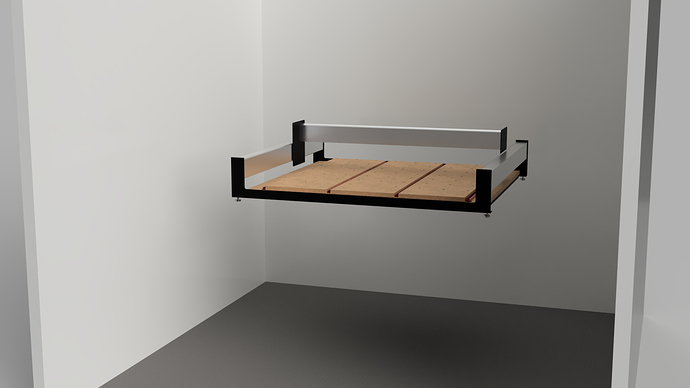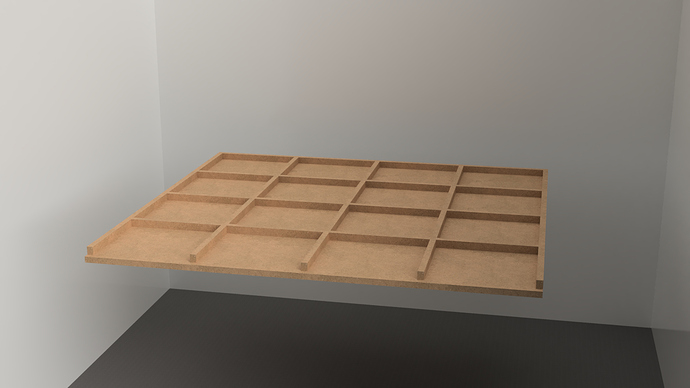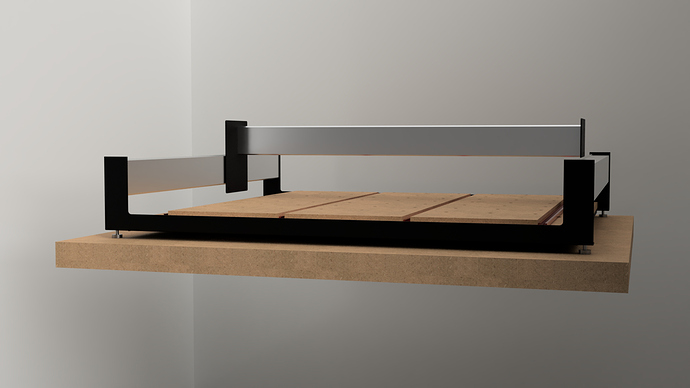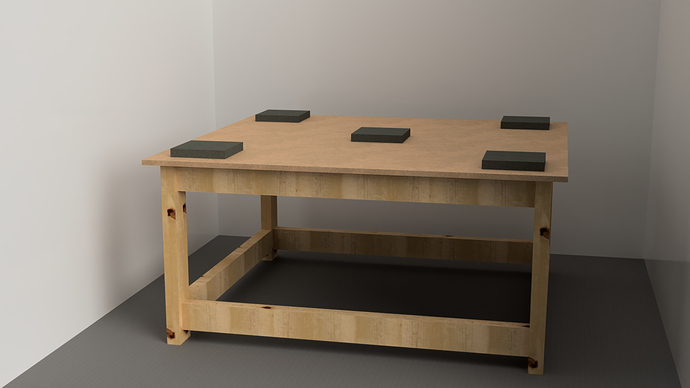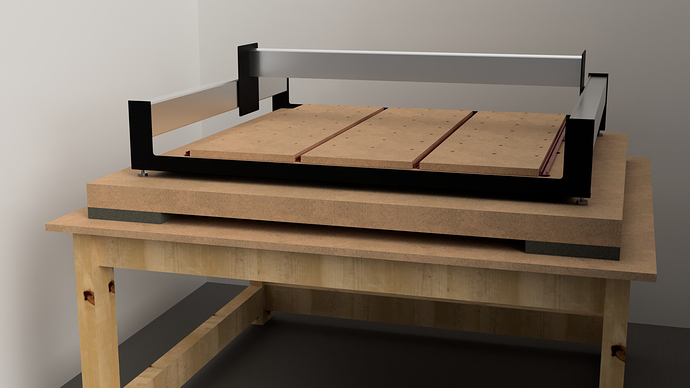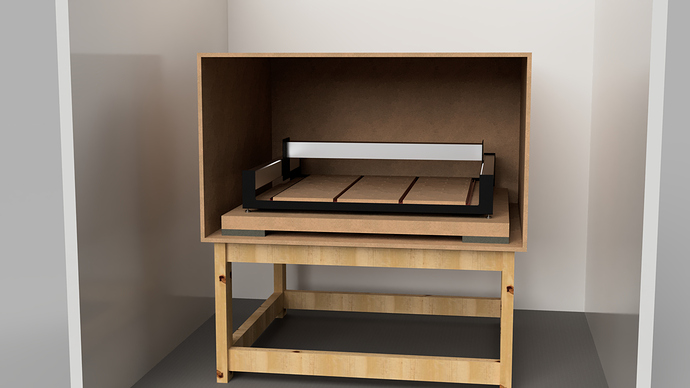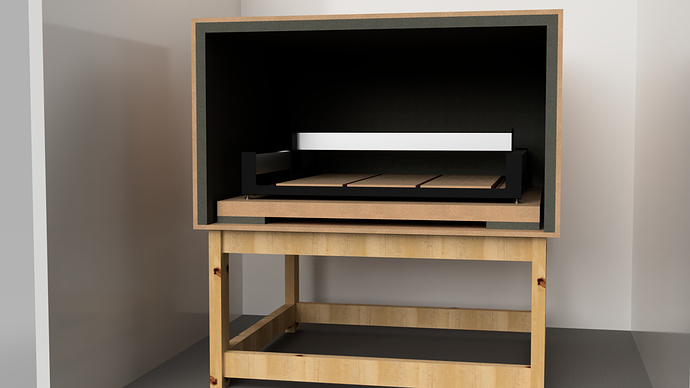Hey, you wouldn’t hear the router spindle ![]()
first off, thank you for giving me such a detailed reply! ’
second, I think some of the things you’re mentioning are a little overkill. I can not get concrete paving slabs in my room and the table is in my closet, which is above the garage so noise below me isn’t a problem.
NP, there’s lots of stuff there, more a sort of menu of what could be done so you could see which bits might work in the space you have.
I just want a simple solution that will cover most of the frequency range. a “one size fits all panel”.
if you had to design a simple panel of layers/sandwiched materials (no split studs), how would you design it.
Im thinking two layers of 1/2" thick plywood with sound dampening glue in-between, a layer of dynamite, and some rigid foam spray painted white.
Let me have a proper think about this tomorrow.
I know there’s a bunch of people on the forum here have made enclosures for their machines and will have practical experience of how much sound they contained.
I watched a bunch of YT vidoes whilst waiting for mine to arrive to see what people said about noise with and without their enclosure. Winston built one, those where you get to hear the machine are helpful.
It seems that a lot of the higher frequency noise is damped out by just being in an enclosure, my garage vacuum for dust extraction made more noise than my Shapeoko until I put that in a box to reduce the noise.
BTW,
Are you the same person who asked about making horn speakers before the forum server had it’s issue?
Yes I am the same person to ask that question about the speaker horns. And yeah my CNC will be in a walk-in closet one of the walls faces the outside of the house the other wall Face is in the closet in the other room so the sound should be pretty well contained just because of where the CNC is located.
Ah great, building speakers is an excellent pasttime, I wholeheartedly support it.
So, you’re after an XXL to go in the closet and cut plywoods and hardwoods?
What options do you have to ventilate the closet to outside for heat / dust extraction exhaust?
Do you have access to a track saw or table saw for making long straight cuts to build things like a torsion box?
Does the closet have a wood or slab floor?
I have a circular saw and some rails and clamps to cut them reasonably straight.
I have an 1100 page book on hifi horn design that I’m going through with a mentor of mine. It uses lots of differential equations as well as lots of calculus. I’ve only taken up to calc 1 and I’m gonna be taking Calc to Calc three and differential equations in the coming years for my degree. Right now I’m just focused on getting the enclosure made all the water pump accessories for my spindle (1500 watt water cooled) and a dust extraction system going.
I just made the table I could probably put some of that dynamat in between the top layer of wood that shapeoko sits on and the 2 x 4 frame that The table top is screwed onto.
I’m not an expert but as far as I know when it comes to vibrations, rather than use a large pad to cover the entire area, you want to minimize contact with the surface below in order to decouple the two surfaces.
For my Nomad, I did this with long strips of a specialty foam that held my enclosure ~10mm away from the bench underneath.
I have a circular saw and some rails and clamps to cut them reasonably straight.
I have an 1100 page book on hifi horn design that I’m going through with a mentor of mine. It uses lots of differential equations as well as lots of calculus. I’ve only taken up to calc 1 and I’m gonna be taking Calc to Calc three and differential equations in the coming years for my degree. Right now I’m just focused on getting the enclosure made all the water pump accessories for my spindle (1500 watt water cooled) and a dust extraction system going.
It’s a long time since my maths was good enough to engage the maths for horns, that’s quite serious stuff, well suited to computational modelling.
Another excellent read on sound recording, reproduction and how humans actually perceive sound, all backed up with real science is Floyd Toole’s book.
So, as promised, here’s some thoughts on how you might put together a reasonably non-housemate aggravating Shapeoko XXL. I’ve been thinking about how I’ve quietened machines and rooms in the past and how those tricks might be adapted.
So, first off, an XXL in a 7 foot by 7 foot room;
In terms of approach, I’d suggest that we try to absorb the noise at source or stop it propagating out into the room, it’s almost always best to do this when you can isolate the noise source. I think this will also be helpful in sawdust containment, one guaranteed thing about milling lots of plywood and hardwood is that you’re going to make a lot of sawdust, not all of it will be captured by the extraction system and an enclosure will help keep the mess inside.
The first thing is a solid base for the Shapeoko to sit on, I’m in the process of bolting mine down to the torsion box bench to stiffen up the wasteboard and frame as advised by others here (sorry, can’t remember who). I built my torsion box way deeper than it needed to be, here’s a rough shot at a more suitably sized unit;
It’s a simple torsion box top and bottom panels held apart by braces, built with MDF or Ply these are stiff and tend to be quite dimensionally stable.
This isn’t isolated from the machine at all, it’s just a rigid support for the machine so you can tram it, level the wasteboard etc. from a flat consistent baseline.
Next up is to support the box on some sort of table, not much to say about this, you might want to use it for storage, put shelves in, it’s a table;
The table has some compliant material on top of it for the torsion box to sit on, the purpose of this is to decouple the Shapeoko and the torsion box from the table, legs and floor to avoid direct mechanical transmission of noise.
As @Moded1952 pointed out, it’s frequently best to use a smaller pad area of the isolation material. Others on the forum here have also suggested other materials, exercise mats etc.
I’ve had pretty good decoupling from blocks of closed cell foam (open cell tends to just collapse), the best decoupling I found was bubble wrap as it’s almost entirely air but the air leaks out over time.
Dynamat and others have materials which are designed for “floating floor” sound decoupling. These tend to be heavy, rubbery and designed to not compact over time under load. These are designed to be used between the base floor and an upper layer of flooring to isolate sound and are made of materials with high losses in shear, doing the job of turning sound into heat and getting rid of it.
I don’t have the modelling capability to select a material here but I’d start with a thick rubbery material and try a few things out to see what works. The idea of the design here is that the pads could be swapped out for you to try different things.
Hopefully this sort of design will provide a solid base for the machine whilst decoupling the mechanical noises from the floor.
The mechanical decoupling was designed to deal with the bass frequencies, now we need to deal with the mid and high frequency noises.
An enclosure of some sort, there’s loads of really good enclosures folks on the forum here have built, I have rendered a simple box here, it ought to have a front, you probably want some sort of window in the front so you can see what the machine is up to. The height tends to be controlled by the height of the spindle and dust collection hoses. It seems to be a good idea to be able to lift your enclosure off the base for working on the machine.
Just the fact of being in an enclosure is going to kill a lot of the high frequency noise, it will reflect from even quite thin materials and not make it out of the enclosure.
The trick when we reflect sound (or get complex and use diffuser panels etc.) is that sound level drops off with the inverse square of distance so if we make it travel a longer path the energy gets spread out, if there’s reflections we can get destructive interference helping out and also most reflections are imperfect and absorb some of the energy.
For the midrange noise we’ll need some sort of sound absorbing material, the heavy rockwool you linked earlier would probably be good, there’s also the heavy, rubbery foams that Dynamat and others sell. The job of this material is to move with the sound waves and absorb the sound energy through friction turning it into heat. This lining material will also help to deal with the unpleasant standing waves this very rectangular box will produce at around 120, 130 and 240Hz (plus harmonics) and the strong 80Hz resonance the square room will have. Rigid foams are good for plugging holes that sound can leak through but not actually absorbing, we need the material to flex to dump the energy as heat.
As you suggested earlier, lining the walls of the enclosure with the material is an excellent start.
It’s best not to have another rigid material in front of the sound absorbtion material but something like rockwool really needs to be contained so for that a thick open weave fabric is a very good way to keep it in place. The more rubbery foam products from vendors like Dynamat might not need any additional protection. A big vote in favour of rockwool is you can get completely non flammable rockwool that just won’t burn.
I hope that’s a decent start for how to keep the noise in the box. I’ve not included anything about dust extraction, those can be noisy and you’ll also want to find a way to get the heat out of the room as @BartK pointed out above.
This topic was automatically closed after 30 days. New replies are no longer allowed.
